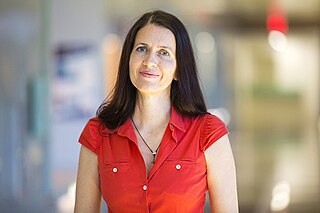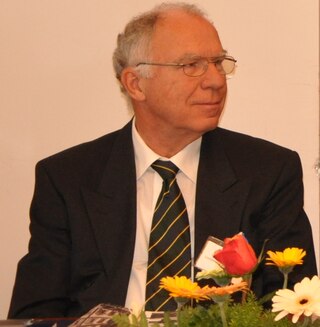Related Research Articles
Computational linguistics is an interdisciplinary field concerned with the computational modelling of natural language, as well as the study of appropriate computational approaches to linguistic questions. In general, computational linguistics draws upon linguistics, computer science, artificial intelligence, mathematics, logic, philosophy, cognitive science, cognitive psychology, psycholinguistics, anthropology and neuroscience, among others.

A joke is a display of humour in which words are used within a specific and well-defined narrative structure to make people laugh and is usually not meant to be interpreted literally. It usually takes the form of a story, often with dialogue, and ends in a punch line, whereby the humorous element of the story is revealed; this can be done using a pun or other type of word play, irony or sarcasm, logical incompatibility, hyperbole, or other means. Linguist Robert Hetzron offers the definition:
A joke is a short humorous piece of oral literature in which the funniness culminates in the final sentence, called the punchline… In fact, the main condition is that the tension should reach its highest level at the very end. No continuation relieving the tension should be added. As for its being "oral," it is true that jokes may appear printed, but when further transferred, there is no obligation to reproduce the text verbatim, as in the case of poetry.
Word-sense disambiguation (WSD) is the process of identifying which sense of a word is meant in a sentence or other segment of context. In human language processing and cognition, it is usually subconscious/automatic but can often come to conscious attention when ambiguity impairs clarity of communication, given the pervasive polysemy in natural language. In computational linguistics, it is an open problem that affects other computer-related writing, such as discourse, improving relevance of search engines, anaphora resolution, coherence, and inference.
Natural language generation (NLG) is a software process that produces natural language output. A widely-cited survey of NLG methods describes NLG as "the subfield of artificial intelligence and computational linguistics that is concerned with the construction of computer systems than can produce understandable texts in English or other human languages from some underlying non-linguistic representation of information".

The Conference and Workshop on Neural Information Processing Systems is a machine learning and computational neuroscience conference held every December. The conference is currently a double-track meeting that includes invited talks as well as oral and poster presentations of refereed papers, followed by parallel-track workshops that up to 2013 were held at ski resorts.

Eduardo Reck Miranda is a Brazilian composer of chamber and electroacoustic pieces but is most notable in the United Kingdom for his scientific research into computer music, particularly in the field of human-machine interfaces where brain waves will replace keyboards and voice commands to permit the disabled to express themselves musically.
Evolutionary music is the audio counterpart to evolutionary art, whereby algorithmic music is created using an evolutionary algorithm. The process begins with a population of individuals which by some means or other produce audio, which is either initialized randomly or based on human-generated music. Then through the repeated application of computational steps analogous to biological selection, recombination and mutation the aim is for the produced audio to become more musical. Evolutionary sound synthesis is a related technique for generating sounds or synthesizer instruments. Evolutionary music is typically generated using an interactive evolutionary algorithm where the fitness function is the user or audience, as it is difficult to capture the aesthetic qualities of music computationally. However, research into automated measures of musical quality is also active. Evolutionary computation techniques have also been applied to harmonization and accompaniment tasks. The most commonly used evolutionary computation techniques are genetic algorithms and genetic programming.

Computational creativity is a multidisciplinary endeavour that is located at the intersection of the fields of artificial intelligence, cognitive psychology, philosophy, and the arts.
Although humor is a phenomenon experienced by most humans, its exact cause is a topic of heavy debate. There are many theories of humor which attempt to explain what it is, what social functions it serves, and what would be considered humorous. Although various classical theories of humor and laughter may be found, in contemporary academic literature, three theories of humor appear repeatedly: relief theory, superiority theory, and incongruity theory. These theories are used as building blocks for the rest of the theories. Among current humor researchers, there has yet to be a consensus about which of these three theories of humor is most viable. Proponents of each theory originally claimed that theirs explained all cases of humor, and that it was the only one capable of doing so. However, they now acknowledge that although each theory generally covers its area of focus, many instances of humor can be explained by more than one theory. Similarly, one view holds that theories have a combinative effect; Jeroen Vandaele claims that incongruity and superiority theories describe complementary mechanisms that together create humor.
An inherently funny word is a word that is humorous without context, often more for its phonetic structure than for its meaning.
The knowledge acquisition bottleneck is perhaps the major impediment to solving the word-sense disambiguation (WSD) problem. Unsupervised learning methods rely on knowledge about word senses, which is barely formulated in dictionaries and lexical databases. Supervised learning methods depend heavily on the existence of manually annotated examples for every word sense, a requisite that can so far be met only for a handful of words for testing purposes, as it is done in the Senseval exercises.
Computer humour, also known as hacker humour, is humour on the subject of computers or their users.
In natural language processing, textual entailment (TE), also known as natural language inference (NLI), is a directional relation between text fragments. The relation holds whenever the truth of one text fragment follows from another text.
Kim Binsted is a professor in the Information and Computer Sciences Department at the University of Hawaiʻi at Mānoa. Binsted's work explores artificial intelligence, human-computer interfaces, and long-duration human space exploration.

Rada Mihalcea is Janice M. Jenkins Collegiate Professor of Computer Science and Engineering at the University of Michigan. She made influential contribution to natural language processing, multimodal processing, and computational social science. She is also the inventor of TextRank Algorithm, which is widely used for text summarization.
Bonnie Jean Dorr is an American computer scientist specializing in natural language processing, machine translation, automatic summarization, social computing, and explainable artificial intelligence. She is a professor and director of the Natural Language Processing Research Laboratory in the Department of Computer & Information Science & Engineering at the University of Florida. Gainesville, Florida She is professor emerita of computer science and linguistics and former dean at the University of Maryland, College Park, former associate director at the Florida Institute for Human and Machine Cognition,, and former president of the Association for Computational Linguistics.

Walther von Hahn is a German linguist and computer scientist. From 1977 to 2007, von Hahn taught Computer Science and Linguistics at Universität Hamburg.
Ellen Riloff is an American computer scientist currently serving as a professor at the School of Computing at the University of Utah. Her research focuses on natural language processing and computational linguistics, specifically information extraction, sentiment analysis, semantic class induction, and bootstrapping methods that learn from unannotated texts.
References
- ↑ Hulstijn, J, and Nijholt, A. (eds.). Proceedings of the International Workshop on Computational Humor. Number 12 in Twente Workshops on Language Technology, Enschede, Netherlands. University of Twente, 1996.
- ↑ Lessard, G. and Levison, M. (1992). Computational modeling of linguistic humour: Tom Swifties. In ALLC/ACH Joint Annual Conference, Oxford, pages 175–178.
- ↑ Binsted, Kim; Ritchie, Graeme (1994). "A symbolic description of punning riddles and its computer implementation". arXiv: cmp-lg/9406021 . Bibcode:1994cmp.lg....6021B.
{{cite journal}}: Cite journal requires|journal=(help). Research Paper 688 University of Edinburgh, Edinburgh, Scotland, 1994, reported at the International Conference on Humor and Laughter, Luxembourg, 1993- (conference proceeding version of the above) An implemented model of punning riddles. In Proceedings of the Twelfth National Conference on Artificial Intelligence (AAAI-94), Seattle, USA.
- 1 2 Graeme Ritchie, Ruli Manurung, Helen Pain, Annalu Waller, Rolf Black, Dave O'Mara. "A practical application of computational humour." In Cardoso, A. & Wiggins, G. (Ed.) Proceedings of the 4th. International Joint Workshop on Computational Creativity, London, UK, 2007, pp. 91–98.
- ↑ STANDUP home page, with a link to free software download
- ↑ "Laughter is the best therapy" Archived June 10, 2007, at the Wayback Machine , The Courier, 19 August 2006
- ↑ "Joke software helps non-speakers", BBC News, 22 August 2006
- ↑ Stock, Oliviero and Strapparava, Carlo
- (2003) "HAHAcronym: Humorous agents for humorous acronyms." Humor: International Journal of Humor Research , 16(3):297–314.
- (2005). "The act of creating humorous acronyms." Applied Artificial Intelligence, 19(2):137–151.
- (2006) Laughing with HAHAcronym, a Computational Humor System, Proceedings of the AAAI Conference on Artificial Intelligence, 21, pp. 1675-1678
- ↑ Chloe Kiddon and Yuriy Brun (2011). "That's What She Said: Double Entendre Identification." In Proceedings of the 49th Annual Meeting of the Association for Computational Linguistics: Human Language Technologies, pages 89–94, Portland, Oregon, USA, June. Association for Computational Linguistics.
- ↑ GitHub – tansaku/twss: A Python project inspired by the research of Chloé Kiddon and Yuriy Brun. Part of the Funniest Computer Ever Open Source initiative
- ↑ Taylor, J. M. and Mazlack, L. J. (2004). "Computationally recognizing wordplay in jokes". In Proceedings of Cognitive Science Conference, pages 2166–2171, Stresa, Italy.
- ↑ "UC Researchers Design Humorous 'Bot'" Archived June 2, 2010, at the Wayback Machine
- ↑ Mihalcea, R. and Strapparava, C. (2006). "Learning to laugh (automatically): Computational models for humor recognition." Computational Intelligence , 22(2):126–142.
- ↑ Osamu Takizawa, Masuzo Yanagida, Akira Ito, and Hitoshi Isahara (1996). "On Computational Processing of Rhetorical Expressions – Puns, Ironies and Tautologies". In (Hulstijn and Nijholt, 1996), 39–52.
- ↑ Rada Mihalcea, Carlo Strapparava, "Technologies That Make You Smile: Adding Humor to Text-Based Applications", IEEE Intelligent Systems , 2006, vol. 21, no.5, pp. 33–39. DOI: http://doi.ieeecomputersociety.org/10.1109/MIS.2006.104
- ↑ Graeme Ritchie (2001) "Current Directions in Computer Humor", Artificial Intelligence Review . 16(2): pages 119–135
- ↑ M.P. Mulder, A. Nijholt, (2002) "Humour Research: State of the Art"
- ↑ Craigh McDonough (2001) "Using Natural Language Processing for random Passwords", Technical Report, CERIAS, Purdue University (unpublished), as quoted by Mulder and Nijholt (2002)
- ↑ John Allen Paulos (1980, 1982) "Mathematics and Humor: A Study of the Logic of Humor", 1982 paperback: ISBN 0-226-65025-1, Japanese translation, 1983, Dutch translation, 1990
- ↑ Shah, H. and Warwick, K., "Machine Humour: Examples from Turing Test Experiments", AI & Society, Vol.32, pp553-561, 2017.